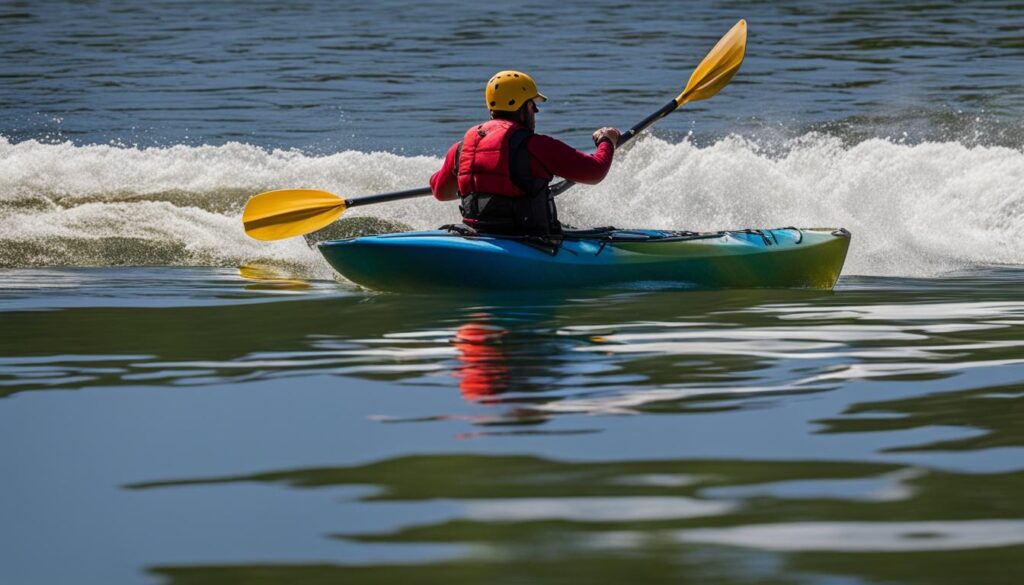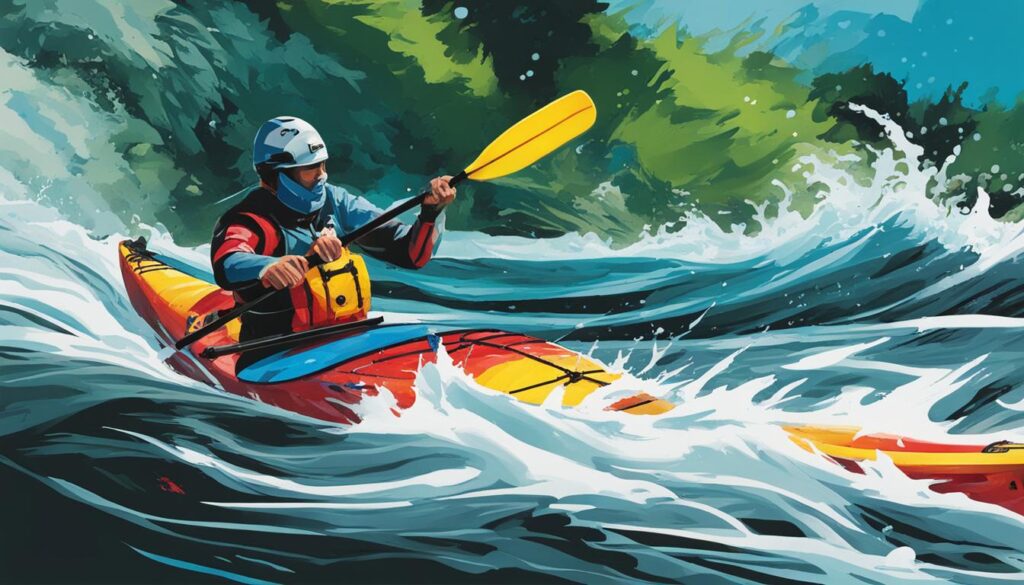Are you ready to take your sea kayaking skills to the next level? If you consider yourself an expert paddler, then advanced sea kayaking techniques can help you unlock your full potential and conquer the waters with confidence. Whether you’re navigating challenging conditions or simply looking to improve your paddling skills, mastering advanced kayaking techniques is essential.
Before diving into the world of advanced paddling, it’s important to have a solid foundation in the basics of kayaking. Understanding different types of kayaks, having knowledge of essential equipment, and practicing proper safety measures are all crucial prerequisites for venturing into advanced techniques.
Physical conditioning is another key aspect of advanced sea kayaking. Cardiovascular fitness, upper body strength, core strength, and flexibility all play a significant role in enhancing performance and reducing the risk of injuries on the water.
Maintaining optimal kayaking posture is essential for effective paddling and injury prevention. By focusing on proper sitting position, foot placement, back alignment, arm position, and torso rotation, you can optimize your paddling power and maneuverability.
Mastering different paddle strokes is a cornerstone of advanced sea kayaking. From the forward stroke that propels you forward to the sweep stroke for turning and the draw stroke for sideways movements, each stroke adds depth and control to your repertoire. Additionally, learning the art of the kayak roll is vital for tackling challenging conditions like whitewater or sea kayaking.
With the right techniques, physical conditioning, posture, and paddle strokes, you’ll be well on your way to becoming an expert sea kayaker. So, let’s dive in and explore the world of advanced sea kayaking together!
Key Takeaways:
- Advanced sea kayaking requires a solid foundation in the basics, physical conditioning, optimal posture, and mastery of different paddle strokes.
- Understanding different types of kayaks and essential equipment is crucial before diving into advanced techniques.
- Physical conditioning, including cardiovascular fitness, upper body strength, core strength, and flexibility, is important for advanced kayakers.
- Maintaining optimal kayaking posture, from sitting position to arm placement and torso rotation, improves paddling performance and reduces the risk of injuries.
- Mastering different paddle strokes, such as the forward stroke, sweep stroke, draw stroke, and kayak roll, provides increased control and maneuverability on the water.
Importance of Physical Conditioning for Kayaking
When it comes to advanced sea kayaking, physical conditioning is key to unlocking your full potential on the water. Building cardiovascular fitness, upper body strength, core strength, and flexibility are essential for improving performance and reducing the risk of injuries.
Cardiovascular fitness plays a crucial role in providing the endurance needed for strenuous kayaking activities. By engaging in regular aerobic exercise such as running, cycling, or swimming, you can enhance your stamina and stay energized during long paddling sessions.
Developing upper body strength is vital for generating powerful paddle strokes. Strong arms, shoulders, and back muscles enable you to execute efficient and controlled movements, propelling your kayak with ease. Incorporate specific strength training exercises like push-ups, pull-ups, and rows into your fitness routine to target these muscle groups.
Core strength is also paramount for stability and powering your paddling movements. A strong core helps maintain balance and control while maneuvering your kayak through challenging waters. Include exercises like planks, Russian twists, and kayak crunches to strengthen your abdominal, oblique, and back muscles.
| Benefits of Physical Conditioning for Kayaking | Exercise Examples |
|---|---|
| Improved endurance | Running, cycling, swimming |
| Enhanced upper body strength | Push-ups, pull-ups, rows |
| Increased core stability | Planks, Russian twists, kayak crunches |
Additionally, flexibility is crucial for maintaining a full range of motion and reducing the risk of strains or injuries while kayaking. Incorporating stretching exercises into your routine, such as yoga or dynamic stretching, can help improve flexibility and keep your muscles supple.
By prioritizing physical conditioning through cardiovascular fitness, upper body strength, core strength, and flexibility, you’ll elevate your kayaking skills to new heights. With a strong and conditioned body, you’ll be ready to take on the challenges of advanced sea kayaking with confidence and control.
Optimal Kayaking Posture

When it comes to advanced sea kayaking, maintaining the correct posture is key to enhancing your paddling performance. By adopting an optimal kayaking posture, you can improve your balance, maximize your power, and minimize the risk of strain or injury. Let’s dive into the essential elements of optimal kayaking posture:
Sitting Position
Start by keeping your back straight and centered in the seat. This helps you maintain stability and distribute your weight evenly. Place your feet against the footpegs, ensuring a firm grip for better control and balance. With this sitting position, you’ll be ready to tackle even the most challenging waters.
Foot Position
Pay attention to your foot position as it plays a crucial role in maintaining stability and control over your kayak. Keep your knees slightly bent and pointing outwards. This position allows you to engage your leg muscles and react quickly to changes in the water. By finding the optimal foot position, you’ll feel more connected to your kayak and have better maneuverability.
Back Position
Maintaining the correct back position is vital for effective paddling. Lean slightly forward from your hips, keeping your back straight. This posture engages your core muscles and allows you to generate power through your strokes. By avoiding slouching or leaning back, you’ll ensure efficient paddling and reduce the risk of strain on your back.
Arm Position
The position of your arms is another important element of optimal kayaking posture. Maintain a comfortable angle at your elbows, allowing for a natural and relaxed position. Avoid tensing up or gripping the paddle too tightly. A light grip and relaxed arms will help prevent fatigue and improve your overall paddling efficiency.
Torso Rotation
To maximize your paddle stroke power, focus on torso rotation. Engage your stronger back and abdominal muscles to facilitate a smooth and powerful stroke. Rotate your torso as you reach forward for each stroke, transferring the power from your core to the paddle. This movement enhances your stroke efficiency and enables you to navigate the waters with ease.
By adopting and maintaining optimal kayaking posture, you’ll unlock your full potential as an advanced kayaker. Remember to practice and refine your posture regularly, as it is the foundation for mastering advanced sea kayaking techniques. With proper posture, you’ll experience improved control, enhanced performance, and a more enjoyable kayaking experience.
Mastering Different Paddle Strokes
When it comes to advanced sea kayaking, mastering various paddle strokes is key to enhancing your paddling skills and maneuverability on the water. Each stroke serves a specific purpose and can be utilized in different situations, allowing you to navigate challenging waters with confidence and control.
Forward Stroke
The forward stroke is the foundation of all kayak paddling techniques. It propels the kayak forward and involves torso rotation for maximum power. To execute a proper forward stroke, engage your core muscles, plant the blade fully in the water, and smoothly pull it backward, following through with a clean exit. This stroke is essential for maintaining a steady pace and covering long distances efficiently.
Sweep Stroke
The sweep stroke is used to turn the kayak and change direction quickly. There are two types of sweep strokes: the reverse sweep and the forward sweep. The reverse sweep starts at the stern and moves towards your feet, while the forward sweep starts at the bow and moves towards the opposite shoulder. Mastering these strokes allows you to navigate tight turns and maneuver through obstacles effectively.
Draw Stroke
The draw stroke is employed to move the kayak sideways, making it useful for approaching docks, avoiding obstructions, or maintaining a steady position against a crosswind or current. To execute a draw stroke, reach out with your paddle blade perpendicular to the kayak’s side, submerge it in the water, and pull the kayak toward the paddle. This stroke requires coordination and precise control to achieve the desired lateral movement.
Bracing Stroke
The bracing stroke helps maintain balance and prevents capsizing in unstable conditions, such as rough waves or strong currents. By using the back or front face of the paddle for support, you can stabilize the kayak and recover from potential tipping situations. Mastering the bracing stroke is essential for building confidence and safety in challenging kayaking environments.
Sculling for Support
Sculling for support is an advanced stroke that provides continuous support against forces like waves or currents. By using a sculling motion with the paddle, you can maintain balance and stability while navigating turbulent waters. This stroke requires practice and coordination to develop the necessary rhythm and control.
By mastering these paddle strokes, you can enhance your sea kayaking skills and confidently tackle a wide range of conditions. Each stroke serves a unique purpose and contributes to your overall control and maneuverability on the water. Practice these techniques regularly to improve your paddling proficiency and take your kayaking adventures to new heights.
| Paddle Stroke | Purpose |
|---|---|
| Forward Stroke | Propels the kayak forward with maximum power and efficiency. |
| Sweep Stroke | Turns the kayak quickly by sweeping the blade in an arc. |
| Draw Stroke | Moves the kayak sideways, useful for docking or avoiding obstacles. |
| Bracing Stroke | Provides stability and prevents capsizing in turbulent conditions. |
| Sculling for Support | Offers continuous support against waves or currents. |

Conclusion
Advanced sea kayaking is an exciting endeavor that requires a strong foundation in the basics, physical conditioning, optimal posture, and mastery of different paddle strokes. By continuously improving and honing your expert paddling skills, you can navigate challenging waters with confidence and control.
Techniques such as the forward stroke, sweep stroke, draw stroke, bracing stroke, and sculling for support offer increased maneuverability and safety on the water. These sea kayaking maneuvers allow you to tackle various conditions and enjoy the thrill of technical sea kayaking.
To further enhance your sea kayaking skills, consider engaging in advanced kayaking courses and gaining practical experience through practice. By applying the tips and techniques highlighted in this guide, you can push your boundaries, ride the waves like a pro, and experience the exhilaration of advanced sea kayaking. Master the art of sea kayaking stroke mastery and unlock the full potential of this exciting water sport.
FAQ
What are some advanced kayaking techniques that can help improve my skills?
Advanced kayaking techniques, such as mastering different paddle strokes, learning to kayak roll, and understanding advanced maneuvers, can help paddlers unlock their full potential and take their skills to the next level.
How important is physical conditioning for advanced sea kayaking?
Physical conditioning plays a significant role in advanced sea kayaking. It is crucial to focus on cardiovascular fitness, upper body strength, core strength, and flexibility to improve performance and reduce the risk of injuries.
What is the optimal kayaking posture?
Maintaining the correct kayaking posture is essential for effective paddling and injury prevention. This involves sitting with a straight back, centered in the seat, feet resting against the footpegs, and maintaining proper arm and torso positions.
Which paddle strokes should I master as an advanced kayaker?
As an advanced kayaker, you should aim to master different paddle strokes for better control and maneuverability on the water. These include the forward stroke, sweep stroke, draw stroke, bracing stroke, and sculling for support.
How can I improve my sea kayaking skills and become an expert paddler?
To become an expert paddler, it is important to continuously improve and hone your paddling skills. Engaging in advanced kayaking courses, practicing regularly, and seeking further skill enhancement through experience can elevate your sea kayaking to new levels of mastery.





